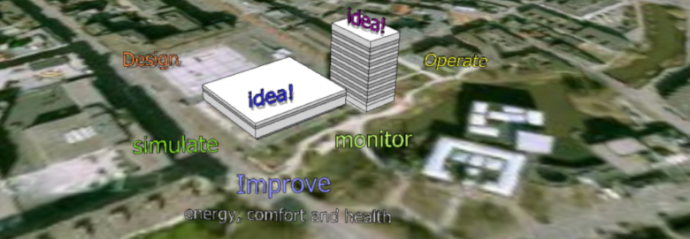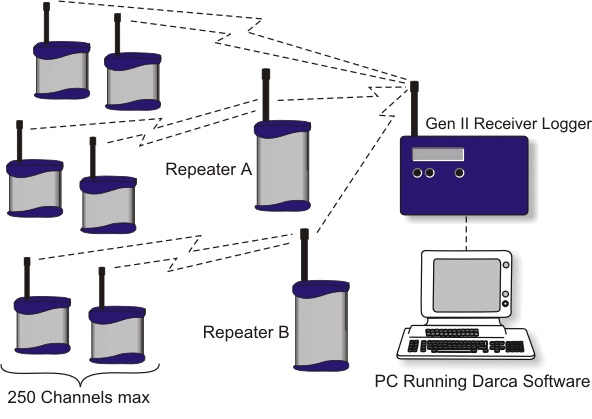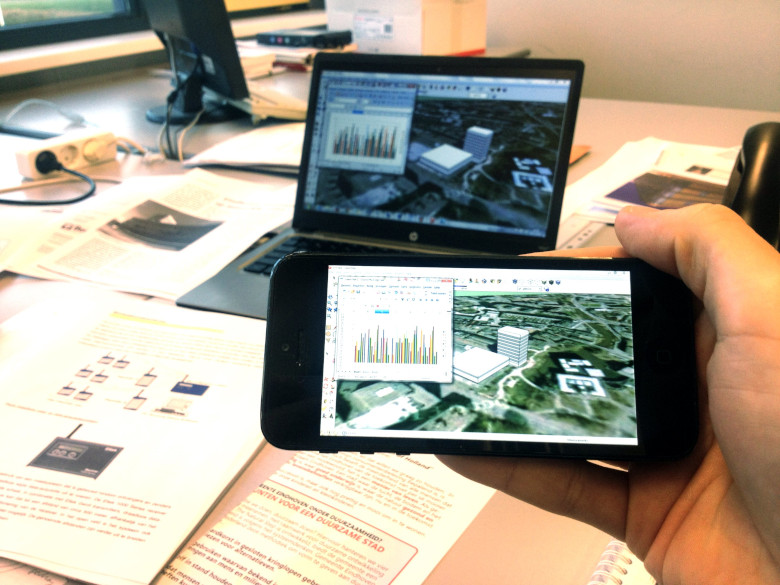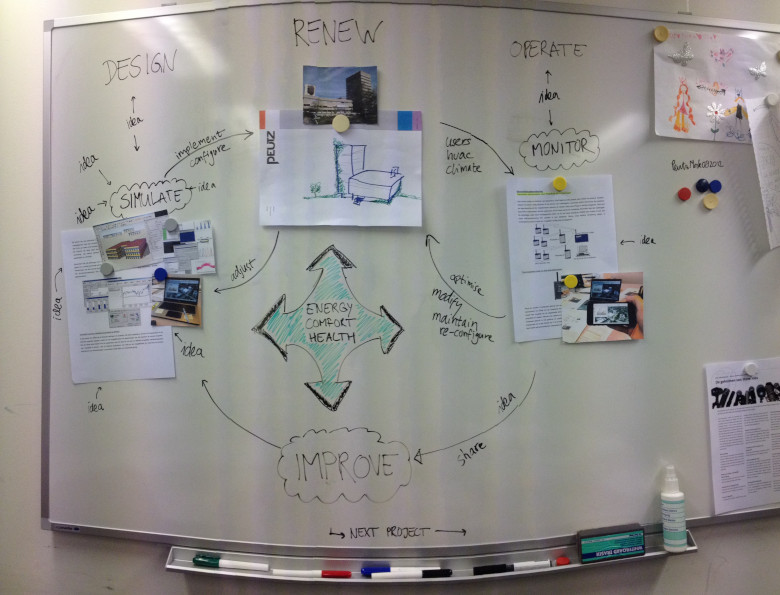
Just an idea for sustainable renovation.
What strikes us
What strikes us is the huge difference between predicted and real energy use in buildings. Many articles about this issue have been published the last years (see references below). It appears to us that sustainability looks good on paper but is little cared about afterwards. Or even more undesirable: it compromises on indoor climate. Are we fooling ourselves? To some extent, yes. Predictions made in the design phase are based on assumptions and internationally agreed standards and values. That's fine if your aim is to compare building designs. But it is not so useful if you care about where the real energy goes. And that we simply don't know. Or at least a large part of it remains undiscovered.
Our view
Our view on sustainability focuses on energy and thermal comfort. Renovation requires less concrete, less steel, less aluminium. That 's good. Further improvements in this field we leave to others. What we want to do is get a grip on the energy bill afterwards without compromising on comfort. In order to get there, we have to start with a solid and thought-through design.
Hi-res image click here (opens in new page)
Our idea
Our idea is to evaluate the wonderful ideas of all the other creatives that have made a contribution to the request for outline proposals by the Eindhoven municipality. The key question we would like to answer is will it contribute to the sustainability ambitions? So we might have to improve or perhaps discard some of the wonderful ideas. We will provide arguments for that.
What we propose
 We propose to make a dynamic building model that can be used in the design phase to simulate as good as possible how the building and its occupants will behave. We're talking really advanced modelling. The software is available. We only have to use it, modify it a little and make intelligent connections between packages. The modelling we suggest implies not only the building envelope and hvac installations but user behaviour and occupancy rates of rooms and floors as well. It should take into account the real outdoor climate, solar gains and infiltration losses. We'll have to make predictions on how new office concepts relate to ventilation needs and energy demand. It will not be an easy task but we know we can. The outcome of the model will be used to further optimise the design. Runs and re-runs of the model are aimed at investigating how each variable influences the results and whether they contribute to maximising thermal comfort while at the same time lowering the energy demand.
We propose to make a dynamic building model that can be used in the design phase to simulate as good as possible how the building and its occupants will behave. We're talking really advanced modelling. The software is available. We only have to use it, modify it a little and make intelligent connections between packages. The modelling we suggest implies not only the building envelope and hvac installations but user behaviour and occupancy rates of rooms and floors as well. It should take into account the real outdoor climate, solar gains and infiltration losses. We'll have to make predictions on how new office concepts relate to ventilation needs and energy demand. It will not be an easy task but we know we can. The outcome of the model will be used to further optimise the design. Runs and re-runs of the model are aimed at investigating how each variable influences the results and whether they contribute to maximising thermal comfort while at the same time lowering the energy demand.
Our role
Our role is to closely co-operate with the design team and feed the team with information. We intend to co-operate with others to address cost optimal levels (what is the ROI?) and address feasibility issues (can we make it?). We care for our independence. We are not connected or related to manufacturers or contractors. Our team consists of experienced and skilled staff tried and tested in international building physics consultancy. We focus on content.
The bridge
We don't stop here. We want to bridge the gap between design predictions and the real world. We want to use the real world information to feed the model and improve it. Not only to make it more useful for the next project, but also to adjust and optimise the renovated building.
Monitoring
 Sensor technology is getting cheaper every day. It has reached a price level that enables us to use many sensors all through the building and its technical installations. We're not just thinking about the air handling units. We want to extract the data from daylight sensors used to dim the artificial lighting. We want to know if windows are open. We want to know how hot, how cold and how comfortable the indoor climate is. We want to monitor presence in meeting rooms. Collect data on CO2- and VOC- (volatile organic compounds) levels as markers for air quality and ventilation rate. We want to know whether the sunshades are up or down or halfway. We want to know how many revolutions the tourniquet at the entrance has made every hour of every day. And how many times the elevators have gone up and down. Most of the office equipment such as copiers, computers and the like are already web-connected. Why not use that information as well. Pantries and kitchens will have their own power submeters. It can be done.
Sensor technology is getting cheaper every day. It has reached a price level that enables us to use many sensors all through the building and its technical installations. We're not just thinking about the air handling units. We want to extract the data from daylight sensors used to dim the artificial lighting. We want to know if windows are open. We want to know how hot, how cold and how comfortable the indoor climate is. We want to monitor presence in meeting rooms. Collect data on CO2- and VOC- (volatile organic compounds) levels as markers for air quality and ventilation rate. We want to know whether the sunshades are up or down or halfway. We want to know how many revolutions the tourniquet at the entrance has made every hour of every day. And how many times the elevators have gone up and down. Most of the office equipment such as copiers, computers and the like are already web-connected. Why not use that information as well. Pantries and kitchens will have their own power submeters. It can be done.
What we can achieve

It will be a huge task to handle all the data and to evaluate its reliability. But if we succeed we'll gain insight in how the building really works. Where the energy really goes. It will allow us to adjust settings, to optimise efficiency, to reconsider maintenance schemes, to educate the users on how to save energy and so on without compromising on comfort. It will give us new ideas and insights that can be tested first with the dynamic building simulation model before implementing them in the real world. We can bridge the gap between design assumptions and the real, actual, operational energy use.
All we learn
All we learn can be used to improve the building. And the next design process. And the next project. It will contribute to the long term sustainability ambitions of the Eindhoven municipality. By co-operating with students, universities and other institutions we can contribute to create awareness. We can start a cycle of learning and improving. That sounds like a wonderful idea to us!
References
- Majcen, D., Itard, L, and Visscher, H.J., Energielabels en werkelijk energiegebruik, TVVL magazine, January 2013.
- Hirsch, A. et.al., The role of modeling when designing for absolute energy use intensity requirements in a design-build framework, ASHRAE Winter conference, Las Vegas, Nevada, February 2011.
- Demanuele, C., Tweddell, T. and Davies, M., Bridging the gap between predicted and actual energy performance in schools, World Renewable Energy Congress XI, Abu Dhabi, UAE, September 2010.
- Santín, O., Actual energy consumption in dwellings: the effect of energy performance regulations and occupant behaviour, TUDelft, IOS Press BV, 2010.
Reacties:
Reactie-mogelijkheden voor dit item zijn gesloten.
